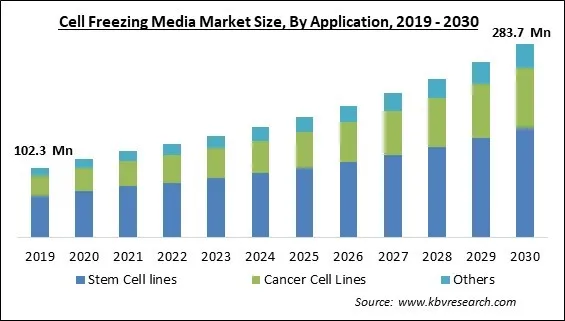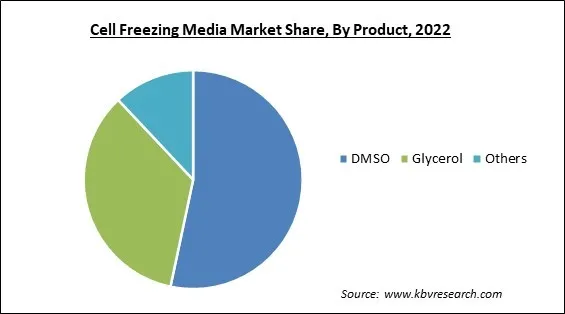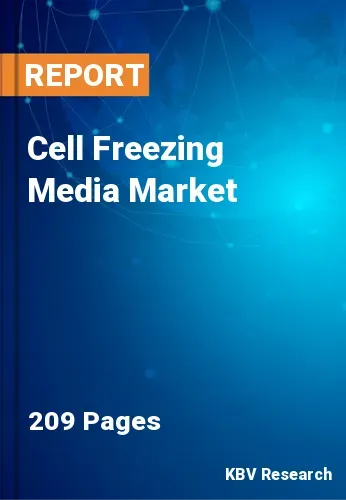The Global Cell Freezing Media Market size is expected to reach $283.7 million by 2030, rising at a market growth of 9.7% CAGR during the forecast period.
Pharmaceutical & Biotechnological Companies are the major end users of cell freezing media for development of biologics, toxicological testing, and drug discovery. Consequently, the pharmaceutical & biopharmaceutical sector would capture more than 45% share of the market by 2030. According to the US Congressional Budget Office, the pharmaceutical sector spent $83 billion on research and development in 2019. These costs were incurred for various activities, including developing and testing novel medications, incremental innovation of product expansions, and clinical testing for marketing or safety monitoring.
Similarly, the pharmaceuticals and biotechnology sector produced goods valued at more than S$16 billion for export in 2016, according to the Singapore Economic Development Board (EDB), a government organization under the Ministry of Trade and Industry. Some of the factors impacting the market are increasing study of cell-based therapies, new developments in cryopreservation technology, and issues with the usage of common cell freezing media.

One of the most significant developments in medicine could come from stem cells. In addition to significantly impacting the development of restorative medicine, their research provides valuable insight into the intricate processes involved in human development. The DNA of the cells reflects how a stem cell differs from a developed cell. DNA is loosely organized in the former cell's functional genes. This process is reversible, and it is well known that interactions between gene sequences can produce such pluripotency. Frozen cells' recovery rates and viability have been improved because of ongoing developments in cryopreservation methods, such as creating better-freezing media formulations. The antifreeze protein, also known as an ice-binding protein, is one of the proteins researchers have attempted to duplicate with biomimetic materials. Numerous research institutes, as well as biopharmaceutical manufacturers, adopted the ready-to-use freezing media as a result of the demand for quicker turnaround times with practical solutions from research operations.
The COVID-19 pandemic had a beneficial effect on the market. For the creation of vaccines, cryopreservation was essential because there were numerous processing phases, including transfer between laboratories. Numerous research institutes, as well as biopharmaceutical manufacturers, adopted the ready-to-use freezing media as a result of the demand for quicker turnaround times with practical solutions from research operations. Additionally, the R&D industry saw increasing investments in partnerships, expansion, and collaboration, which fueled market expansion.
However, the rate of recovery of cells following freezing is one of the key drawbacks of existing cryopreservation techniques. Because of high recovery rates, researchers must wait for the cells to multiply when working on a research project, which might not be possible for clinical applications. However, the cryoprotectant, DMSO, is harmful to cells in some quantities, making it one of the downsides of cryoprotectants. which might be problematic. Hence, these elements can hamper the market's growth in the coming years.
Based on product, the market is characterized into DMSO, glycerol, and others. The glycerol segment procured a considerable growth rate in the market in 2022. Due to its non-electrolyte nature, glycerol has the potential to function by lowering the electrolyte concentration of the remaining unfrozen solution around and in a cell at any particular temperature. It is frequently utilized to store germs and animal sperm. The major producers are also coordinating their cell freezing media offerings with the demand for varying CPA concentrations in the market. As a result, they can broaden their consumer base and conduct inclusive research, both of which will help them generate more income.

On the basis of application, the market is classified into stem cell lines, cancer cell lines, and others. The stem cell lines segment acquired the largest revenue share in the market in 2022. The need for biopharmaceuticals is increasing due to effective therapies like gene and cell therapy and an uptick in innovation that has led to an increase in approvals. These are the main driving forces behind the segment's rise. In the coming years, the U.S. FDA is anticipated to approve many more cell and gene therapy products annually as a result of the existing clinical success rates as well as the product pipeline. The anticipated rise in demand has prompted market players to establish an effective supply chain for all consumables.
By end-use, the market is divided into pharmaceutical & biotechnological companies, research & academic institutes, and others. The research and academic institutes segment garnered a remarkable growth rate in the market in 2022. The rapid expansion of the segment can be attributed to an increase in R&D efforts during the predicted period. The COVID-19 outbreak made industry experts more conscious of the need for ongoing study and development of current technologies. Huge investments in alliances and teamwork with research institutes contribute to the anticipated growth.
| Report Attribute | Details |
|---|---|
| Market size value in 2022 | USD 137.3 Million |
| Market size forecast in 2030 | USD 283.7 Million |
| Base Year | 2022 |
| Historical Period | 2019 to 2021 |
| Forecast Period | 2023 to 2030 |
| Revenue Growth Rate | CAGR of 9.7% from 2023 to 2030 |
| Number of Pages | 209 |
| Number of Table | 350 |
| Report coverage | Market Trends, Revenue Estimation and Forecast, Segmentation Analysis, Regional and Country Breakdown, Companies Strategic Developments, Company Profiling |
| Segments covered | Product, Application, End-use, Region |
| Country scope | US, Canada, Mexico, Germany, UK, France, Russia, Spain, Italy, China, Japan, India, South Korea, Singapore, Malaysia, Brazil, Argentina, UAE, Saudi Arabia, South Africa, Nigeria |
| Growth Drivers |
|
| Restraints |
|
Region wise, the market is analyzed across North America, Europe, Asia Pacific, and LAMEA. The North America segment procured the highest revenue share in the market in 2022. The existence of developed economies, significant players, and well-established supply channels all contribute to the market's overall growth. The rush to produce cutting-edge and effective treatments through the biopharmaceutical industry has also been fueled by the frequency of diseases and the rise in seniors. This has sparked a need for cell freezing media and is anticipated to continue in the future.
Free Valuable Insights: Global Cell Freezing Media Market size to reach USD 283.7 Million by 2030
The market research report covers the analysis of key stake holders of the market. Key companies profiled in the report include Thermo Fisher Scientific, Inc., Merck KGaA, Sartorius AG, Bio-Techne Corporation, HiMedia Laboratories Pvt. Ltd., BPS Bioscience, Inc., BioLife Solutions, Inc., PromoCell GmbH, Capricorn Scientific GmbH, and Cell Applications, Inc.
By Product
By Application
By End-Use
By Geography


The Market size is projected to reach USD 283.7 million by 2030.
New developments in cryopreservation technology are driving the Market in coming years, however, Issues with the usage of common cell freezing media restraints the growth of the Market.
Thermo Fisher Scientific, Inc., Merck KGaA, Sartorius AG, Bio-Techne Corporation, HiMedia Laboratories Pvt. Ltd., BPS Bioscience, Inc., BioLife Solutions, Inc., PromoCell GmbH, Capricorn Scientific GmbH, and Cell Applications, Inc.
The DMSO segment is leading the Global Cell Freezing Media Market by Product in 2022 and would continue to be a dominant market till 2030; thereby, achieving a market value of $147.2 Million by 2030.
The Pharmaceutical & Biotechnological Companies segment acquired the maximum revenue share in the Global Cell Freezing Media Market by End-use in 2022 thereby, achieving a market value of $132.3 Million by 2030.
The North America region dominated the Global Cell Freezing Media Market by Region in 2022 and would continue to be a dominant market till 2030; thereby, achieving a market value of $104.3 Million by 2030.
Our team of dedicated experts can provide you with attractive expansion opportunities for your business.

